Related Research Articles

Copepods are a group of small crustaceans found in nearly every freshwater and saltwater habitat. Some species are planktonic, some are benthic, a number of species have parasitic phases, and some continental species may live in limnoterrestrial habitats and other wet terrestrial places, such as swamps, under leaf fall in wet forests, bogs, springs, ephemeral ponds, and puddles, damp moss, or water-filled recesses (phytotelmata) of plants such as bromeliads and pitcher plants. Many live underground in marine and freshwater caves, sinkholes, or stream beds. Copepods are sometimes used as biodiversity indicators.

Poecilostomatoida are an suborder of copepods. Although it was previously considered a separate order, recent research showed it to be nested within the Cyclopoida
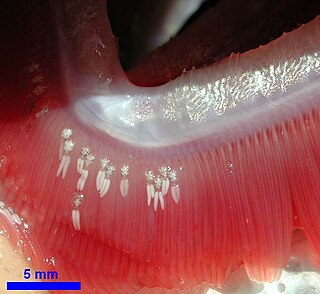
Ergasilidae is a widespread family of copepods and comprises many species. The type genus is Ergasilus. With a few doubtful exceptions all ergasilids are parasitic on fishes.
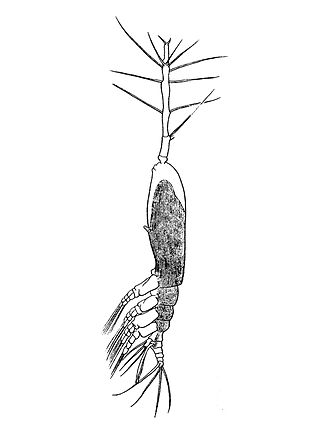
Monstrilloida is an order of copepods with a cosmopolitan distribution in the world's oceans. The order contains a single family, Monstrillidae. The name of the first ever described genus Monstrilla is derived from latin, meaning "tiny monster", because the lack of usual diagnostic features of copepods puzzled early taxonomists.
Bomolochidae is a family of copepods parasitic on marine fishes. Most species parasitize the gills of fish, but some species live in the nostrils or on the eyes of their hosts. The family contains just over 150 species from the following genera:
Paralubbockia longipedia is a species of copepod, and the only member of the family Paralubbockiidae. The family is characterised by the ventral position of the fifth legs, the possession of a separate maxillary palp, and the form of the endopods of the legs and antennae. The closest relatives of Paralubbockia are the family Oncaeidae. Initially placed among the Poecilostomatoida, Paralubbockia is now considered part of the Cyclopoida.

Oleksandr Prokopovych Markevych, in English more often Aleksandr Prokofyevich Markevich was a Ukrainian zoologist, and a prolific helminthologist and copepodologist. He was professor and an Academician of the National Academy of Sciences of Ukraine.
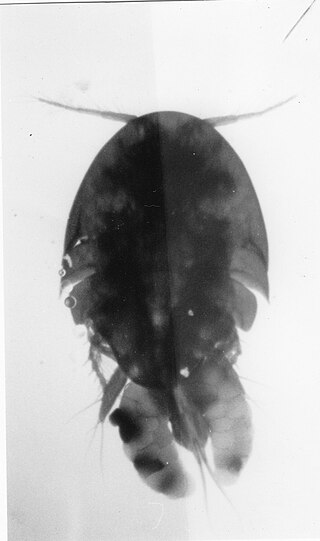
Clausidium is a genus of copepods that have been found in subtopical to temperate coastal areas along the Pacific, Atlantic and Gulf coasts of North America, the Pacific and Atlantic Coasts of South America, the Atlantic and Mediterranean coasts of Europe, the Atlantic coast of Africa, and the coast of India.
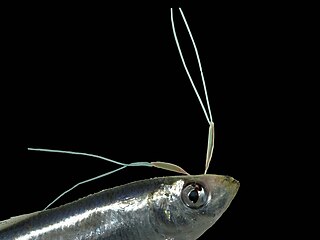
Pennellidae is a family of parasitic copepods. When anchored on a host, they have a portion of the body on the outside of the host, whereas the remaining anterior part of the parasite is hidden inside tissues of the host.

Lernaeocera branchialis, sometimes called cod worm, is a parasite of marine fish, found mainly in the North Atlantic. It is a marine copepod which starts life as a small pelagic crustacean larva. It is among the largest of copepods, ranging in size from 2 to 3 millimetres when it matures as a copepodid larva to more than 40 mm as a sessile adult.

Lernaeopodidae is a family of parasitic copepods. The females are typically large and fleshy, and attach to the host permanently using a plug made of chitin called the bulla. The males cling on to the females using their antennae. They parasitize both marine and freshwater fish. Some lernaeopodids, including Clavella and Salmincola, can have negative impacts on fish in aquaculture.
Pennella is a genus of large copepods which are common parasites of large pelagic fishes. They begin their life cycle as a series of free-swimming planktonic larvae. The females metamorphose into a parasitic stage when they attach to a host and enter into its skin. The males are free swimming. Due to their large size and mesoparasitic life history there have been a number of studies of Pennella, the members of which are among the largest of the parasitic Copepoda. All species are found as adults buried into the flesh of marine bony fish, except for a single species, Pennella balaenopterae which can be found in the muscles and blubber of cetaceans and occasionally other marine mammals, and is the largest species of copepod.
Pennella balaenopterae is a large ectoparasitic copepod specialising in parasitising marine mammals. It is the largest member of the genus Pennella, the other species of which are parasites of larger marine fish.
Eudactylinidae is a family of copepods most of which live as parasites on the gills of elasmobranch fishes; two genera lives on the gills of teleost fishes. The family Eudactylinidae contains the following genera:
Tracheliastes polycolpus is a species of copepod in the family Lernaeopodidae. It is an ectoparasite of a number of freshwater fish in Western Europe, including the beaked dace Leuciscus burdigalensis, the common dace Leuciscus leuciscus, and occasionally a few other fish species. The subspecies Tracheliastes polycolpus baicalensis has been described from Lake Baikal. The parasite attaches itself to the fins of the host, and lives on the mucus and epithelial cells of the host.
Archidactylina is a genus of copepods that contains only the species Archidactylina myxinicola, and is the only genus in the family Archidactylinidae. It is a parasite of the gill pouches of two species of hagfish found in Japanese waters, Eptatretus okinoseanus and Myxine garmani.
Peniculisa is a genus of marine parasitic copepods in the family Pennellidae.

Peniculus is a genus of marine copepods in the family Pennellidae. They occur worldwide and typically parasitize coastal or epipelagic fish, with the exception of Peniculus hokutoae that was found parasitizing a mesopelagic myctophid, Symbolophorus evermanni.
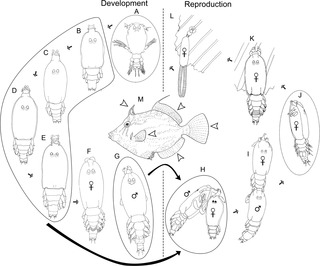
Peniculus minuticaudae is a species of parasitic pennellid copepod. It is known from the northeast Pacific Ocean. It was originally described in 1956, redescribed in 2012, and its complete life cycle has been elucidated on the cultured threadsail filefish, Stephanolepis cirrhifer in 2013.

Bryconops giacopinii is a mid-sized species of freshwater fish in the family Iguanodectidae. It is the largest member of the genus Bryconops, and is therefore difficult to confuse with any of its congeners. With a diet that consists largely of land-dwelling insects, it serves as an important link between the terrestrial and aquatic aspects of its native range.
References
- 1 2 3 4 Muriel-Hoyos, Felipe; Santana-Piñeros, Ana María; Cruz-Quintana, Yanis; Suárez-Morales, Eduardo (November 2015). "A new species of Ergasilus Nordmann, 1832 (Copepoda: Cyclopoida: Ergasilidae) from Bryconops giacopinii Fernández-Yépez (Characidae) in the Vichada River Basin, Colombia". Systematic Parasitology. 92 (3): 241–249. doi:10.1007/s11230-015-9599-3. PMID 26446546. S2CID 18729069 . Retrieved 22 November 2022.
- ↑ Damborenea, Cristina; Rogers, D. Christopher; Thorp, James H. (26 June 2020). Thorp and Covich's freshwater invertebrates. Volume V, Keys to neotropical and Antarctic fauna (Fourth ed.). Amsterdam: Academic Press. p. 788. ISBN 9780128042663 . Retrieved 22 November 2022.
- 1 2 "Parasite Introduction". USGS Great Lakes Science Center: Great Lakes Copepods. United States Geological Survey. Retrieved 22 November 2022.
- ↑ "Ergasilus spp.". UNH Center for Freshwater Biology. University of New Hampshire. Retrieved 22 November 2022.
- ↑ Boxshall, Geoff; Chad, T. Walter. "Ergasilus von Nordmann, 1832". World Register of Marine Species. Flanders Marine Institute. Retrieved 22 November 2022.
- ↑ Walter, T. Chad. "Ergasilus curticrus Muriel-Hoyos, Santana-Pineros, Cruz-Quintana & Suarez-Morales, 2015". World Register of Marine Species. Flanders Marine Institute. Retrieved 22 November 2022.
- ↑ Geoff, Boxshall. "Ergasilus yandemontei Waicheim, Mendes Marques, Rauque & Viozzi, 2021". World Register of Marine Species. Flanders Marine Institute. Retrieved 22 November 2022.
- ↑ von Nordmann, Alexander (1832). Mikrographische Beiträge zur Naturgeschichte der wirbellosen Thiere: Band 1. Berlin: Reimer Verlag. pp. 143–152. ISBN 9781273735165 . Retrieved 22 November 2022.
- ↑ Chivetta, Mary (2012). "The prevalence and effects of Ergasilus (gill lice) on fish species in two Northern Wisconsin lakes" (PDF). University of Notre Dame Environmental Research Center. Retrieved 22 November 2022.
{{cite journal}}: Cite journal requires|journal=(help) - 1 2 Gaviria, Santiago; Aranguren-Riaño, Nelson (15 June 2019). "Continental copepods (Crustacea: Hexanauplia) of Colombia: revision and additions to the inventory". Biota Colombiana. 20 (1): 50–74. doi: 10.21068/c2019.v20n01a04 . Retrieved 22 November 2022.
- ↑ Orsi, Taisa Mendes Marques (18 December 2018). "Sistemática e História Evolutiva de Ergasilidae (Crustacea: Copepoda: Cyclopoida)" (in Spanish). Curitiba: Universidade Federal do Paraná. Retrieved 22 November 2022.
{{cite journal}}: Cite journal requires|journal=(help) - ↑ Ho, Ju-Shey (February 1978). "Marine Flora and Fauna of the Northeastern United States. Copepoda: Cyclopoids Parasitic on Fishes" (PDF). NOAA Technical Report Circular. 409. Retrieved 23 November 2022.
- 1 2 Kilian, Esmari; Avenant-Oldewage, Annemariè (December 2013). "Infestation and Pathological Alterations by Ergasilus sarsi (Copepoda) on the Tanganyika Killifish from Africa". Journal of Aquatic Animal Health. 25 (4): 237–242. doi:10.1080/08997659.2013.812874. PMC 3805422 . PMID 24341764.
- ↑ "Ergasilus sieboldi" (PDF). Environment Agency Fact Sheets. UK Institute of Fisheries Management. Retrieved 23 November 2022.
{{cite journal}}: Cite journal requires|journal=(help)